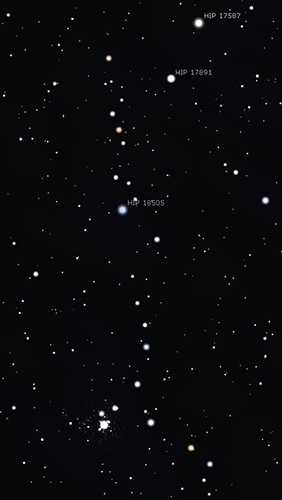
Fr. Lucian Kemble attended the MKSP back in its first decade. I found him delightful in conversation, which was continually interrupted on our walks whenever he saw a little weed poking through a clump of mud, prompting him to exclaim on the beauty of the Creation. For me, he was the “Everlasting Yes” in counterpoint to querulous John Dobson’s “Everlasting No”: in other words, Mt. Kobau embraced the extremes of spiritual insights, from cosmic theism to cosmic atheism. In his 7 X 35 mm binos, Fr. Kemble found his “Cascade,” as named by Walter Scott Houston in his legendary “Deep Sky Wonders” column for Sky & Telescope.
Kemble’s Cascade is a tumbling 2.5 degree-line of 20+ stars, 7th to 9th mag. Near its midpoint, there is a brighter star of 4.9 magnitude. This fetching asterism also features several orange stars towards its NW reach. It is usually best observed, as Kemble himself found it, in binoculars, of at least seven to ten power with a field that can frame its 2.5 degree extent.
The Cascade, as it slides down to the SE, ends in a “splash” at the open cluster NGC 1502. That open cluster has more than three dozen stars, many of them doubles, in a 7’ area. An attractive blue and gold double is in the NE, opposite the base of its vaguely triangular shape. As a visual deep-sky object, it is usually ranked four stars out of five.
Moving a bit more than a degree to the south of 1502, we see the planetary nebula NGC 1501, nearly 1 minute across with a bluish tinge to its mottled disc. Its central star shines steadily at higher powers, say, over 200X. At lower magnifications, the star may blink in and out of view. It is given four stars out of five for its visual impact in one’s telescope.
Retracing our steps back from 1501 and 1502 and following Kemble’s Cascade to the NW, we come upon U, a carbon star. From U, we proceed just over four degrees to the north, in the direction of Polaris, and arrive at a Challenge Object, IC 342, a face-on spiral galaxy 22’ in diameter (over one-third degree). Its surface brightness or luminance is mag 15.0, which is quite faint, although I first observed IC 342 in an eastern suburb of Vancouver (Campbell Valley Park, Langley area) through my 10.1” Coulter Odyssey Compact telescope, the instrument that first revealed, visually, what the Universe looks like, even in larger scopes such as my 17.5”and the 25” “Wolankovick” that has been at past sessions of the MKSP and the MSQ near Merritt. Choosing just the right magnification or exit pupil is a key to observing this IC object: an exit pupil of three, for example, may work well. Discerning the difference between the faint halo of the galaxy and the background sky is the reason for the challenge associated with IC 342 and its rank of three stars out of five.
The title ”Six Degrees of Separation” for this handout refers to the fact that these remarkable deep-sky objects are all within six or seven degrees of one another. Perhaps all the more remarkable is the fact that these objects are located in Camelopardalis, a constellation often overlooked for being unremarkable! The most commonly observed deep-sky object in Cam is probably NGC 2403, an outlying member of the M81-82 group; but that is far away from our part of this sprawling Giraffe and lacks the variety we have found in our little compact space.
… Lee Johnson 2022
